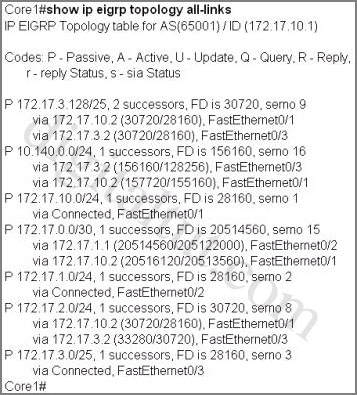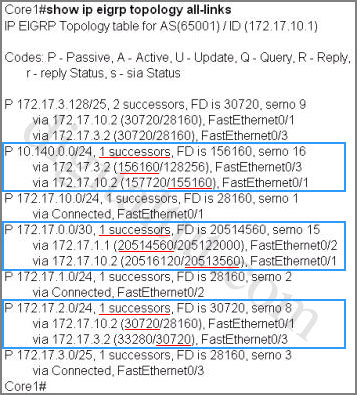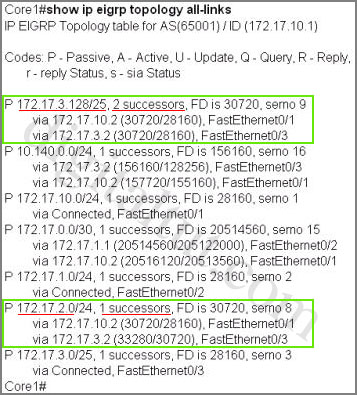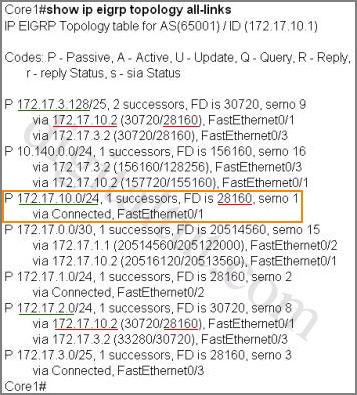EIGRP - SHOW IP EIGRP TOPOLOGY ALL-LINKS
Question
Refer to the exhibit. BigBids Incorporated is a worldwide auction provider. The network uses EIGRP as its routing protocol throughout the corporation. The network administrator does not understand the convergence of EIGRP. Using the output of the show ip eigrp topology all-links command, answer the administrator’s questions.

Question 1
Which two networks does the Core1 device have feasible successors for? (Choose two)
A – 172.17.0.0/30
B – 172.17.1.0/24
C – 172.17.2.0/24
D – 172.17.3.0/25
E – 172.17.3.128/25
F – 10.140.0.0/24
Answer: A F
Explanation
To understand the output of the “show ip eigrp topology all-links command” command, let’s analyze an entry (we choose the second entry because it is better for demonstration than the first one)

The first line tells us there is only 1 successor for the path to 10.140.0.0/24 network but there are 2 lines below. So we can deduce that one line is used for successor and the other is used for another route to that network. Each of these two lines has 2 parameters: the first one (“156160″ or “157720″) is the Feasible Distance (FD) and the second (“128256″ or “155160″) is the Advertised Distance (AD) of that route.
The next thing we want to know is: if the route via 172.17.10.2 (the last line) would become the feasible successor for the 10.140.0.0/24 network. To figure out, we have to compare the Advertised Distance of that route with the Feasible Distance of the successor’s route, if AD <>
After understanding the output, let’s have a look at the entire output:

Because the question asks about feasible successor so we just need to focus on entries which have more paths than the number of successor. In this case, we find 3 entries that are in blue boxes because they have only 1 successor but has 2 paths, so the last path can be the feasible successor.
By comparing the value of AD (of that route) with the FD (of successor’s route) we figure out there are 2 entries will have the feasible successor: the first and the second entry. The third entry has AD = FD (30720) so we eliminate it.
Question 2
Which three EIGRP routes will be installed for the 172.17.3.128/25 and 172.17.2.0/24 networks? (Choose three)
A – 172.17.3.128.25 [90/28160] via 172.17.1 2, 01:26:35, FastEthernet0/2
B – 172.17.3.128/25 [90/30720] via 172.17.3.2, 01:26:35. FastEthemet0/3
C – 172.17.3.128/25 [90/30720] via 172.17.10.2, 01:26:35. FastEthernet0/1
D – 172.17.2.0/24 [90/30720] via 172.17.10.2, 02:10:11, FastEthernet0/1
E – 172.17.2.0/24 [90/28160] via 172.17.10.2, 02:10:11. FastEthernet0/1
F – 172.17.2.0/24 [90/33280] via 172.17.3.2, 02:10:11. FastEthernet0/3
Answer: B C D
Explanation
First indicate the positions of these networks:

Network 172.17.3.128/25 has 2 successors, therefore the two paths below are both successors.
Network 172.17.2.0/24 has only 1 successor, therefore the path lies right under it is the successor.
Question 3
Which three networks is the router at 172.17.10.2 directly connected to? (Choose three)
A – 172.17.0.0/30
B – 172.17.1.0/24
C – 172.17.2.0/24
D – 172.17.3.0/25
E – 172.17.3.128/25
F – 172.17.10.0/24
Answer: C E F
Explanation

First, we should notice about the entry in the orange box, it shows that the network 172.17.10.0/24 is directly connected with this router and has a FD of 28160. So we can guess the networks that directly connected with router at 172.17.10.2 will be shown with an AD of 28160. From that, we find out 3 networks which are directly connected to the router at 172.17.10.2 (they are green underlined). The network 172.17.10.0/24 is surely directly connected to the router at 172.17.10.2 (in fact it is the network that links the router at 172.17.10.2 with Core1 router).

